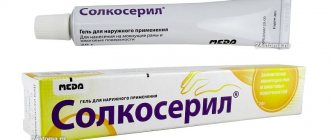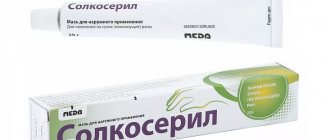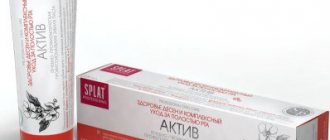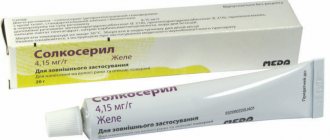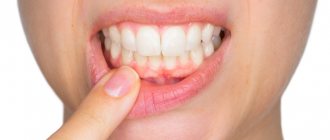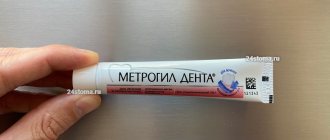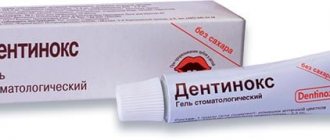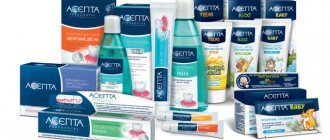From this article you will learn:
- indications for use,
- instructions for use in the oral cavity,
- composition analysis, analogues, price 2022.
The article was written by a dentist with more than 19 years of experience.
Solcoseryl dental adhesive paste is a dental preparation based on deproteinized dialysate from the blood of calves, which is intended to accelerate the healing of ulcers, erosions and traumatic injuries of the oral mucosa. The drug can only be used on moist mucous membranes and, accordingly, it is not suitable for the treatment of wounds and skin lesions. In the latter cases, you should use Solcoseryl forms - in the form of a gel or ointment.
The drug is produced by an international pharmaceutical company and is registered as a “medicinal product”. In addition, it has no age restrictions and is available without a prescription. Solcoseryl dental paste has the appearance of a pale yellow homogeneous granular mass. If you squeeze the paste out of the tube, you will notice that it has a slightly dry consistency. Despite this, the paste is easily distributed and firmly fixed on the oral mucosa, while also performing the function of a protective bandage. The latter is very important, because if there are erosions on the mucous membrane, eating will be very painful.
Solcoseryl dental paste: photo of packaging
Indications for use –
- for stomatitis – to accelerate the healing of ulcers and relieve pain (Fig. 3),
- after surgical operations in the oral cavity,
- bedsores under dentures
- for the treatment of jamming in the corners of the mouth,
- to accelerate the healing of the socket of an extracted tooth with alveolitis (Fig. 4).
This article was written by a dental surgeon, and in some cases that require clarification, the optimal solution for these indications will still be not adhesive dental paste, but Solcoseryl in gel form. In our opinion, for stomatitis, the paste will be optimal only in the presence of deep ulcerations, and for superficial erosions it will be better to use a gel. The same applies to the treatment of bedsores under dentures. For a detailed description of the use of the drug, read below.
What is Solcoseryl ointment used for?
The drug is based on deproteinized dialysate obtained through special processing from the blood of calves. This substance is often used in medicine in countries such as China, Korea, and the entire CIS. It has proven itself to be an effective remedy that can:
- enrich tissue cells damaged due to hypoxia with oxygen and glucose;
- start tissue repair processes;
- activate healthy cell division processes;
- increases the level of energy produced by cells;
- protects the skin from external damage by forming a film on its surface;
- triggers the production of collagen by tissues.
Based on the activity of the drug, the drug can be used for:
- frostbite;
- psoriasis;
- anal ring cracks;
- cuts;
- abrasions;
- scratches;
- bedsores;
- acne marks;
- dermatitis;
First of all, to achieve the best effect, it is necessary to start therapy in the early stages of the problem.
Deproteinized dialysate from calf blood - indications for use
The following list of indications for use is determined by the presence in the drug of deproteinized dialysate obtained from the blood of dairy calves. The dialysate contains a large number of active substances and growth factors that accelerate regeneration processes in the skin and mucous membrane. Indications for use of Solcoseryl gel –
- wet wounds on the skin and red border of the lips,
- trophic ulcers on the skin,
- erosions and ulcers of the oral mucosa,
- bedsores under removable dentures,
- injuries to the mucous membrane from removable and fixed dentures, sharp edges of fillings.
Once again, we draw your attention to the fact that when using the drug on the skin and red border of the lips, the indication for use is only wet wounds. Those. wounds must not be covered with crusts and have a moist discharge. If the wound is covered with dry crusts and there is no wet discharge, then according to the instructions for use, it is necessary to use not a gel, but Solcoseryl in the form of an ointment.
If you plan to treat the oral mucosa, then keep in mind that the gel form is optimal for superficial lesions of the mucous membrane - shallow ulcers, burns, bedsores under dentures. But if the ulcer is deep enough, or you need to cure alveolitis in the hole of an extracted tooth, then in this case it is better to use another form of this drug - Solcoseryl dental paste.
Solcoseryl ointment as a face mask
Cosmetologists claim that the use of Solcoseryl in the early stages of age-related changes allows you to maintain youthful skin. Timely start of use can replace expensive laser rejuvenation in the salon. First of all, Solcoseryl allows you to get rid of wrinkles and prevent their earlier appearance. The ointment is capable of:
- provide adequate nutrition to the facial skin;
- get rid of acne;
- relieve inflammation;
- improve complexion;
- tighten the oval;
- get rid of wrinkles.
The expected effects are possible due to the fact that using a mask allows you to saturate tissues and cells with oxygen and accelerate regeneration. Thanks to the application of the cream, collagen, which is responsible for skin elasticity, begins to be actively produced. The more collagen produced, the fewer wrinkles your skin will have. It is like a support for a heavy skin sheet, preventing its individual areas from falling through, preventing the formation of wrinkles.
Special instructions -
- The drug is safe for use in children, including infants.
- Solcoseryl dental adhesive paste cannot be applied to an infected wound, because it does not contain antimicrobial components.
- Before applying the paste, always treat the application area with an antiseptic.
- If fever appears, as well as redness, pain and swelling in the area of the mucous membrane near the site of application of Solcoseryl, or if discharge appears from the wound, you should consult a doctor.
- If, when using the drug, the ulcer does not heal within 10 days, you should also consult a doctor, because this may indicate oncology. We hope that our article on the topic: Solcoseryl dental adhesive paste instructions - turned out to be useful to you!
Sources:
1. Dental education of the author of the article, 2. Personal experience as a maxillofacial surgeon, dental surgeon, 3. Official website of the manufacturer – https://solcolife.ru/, 4. “Outpatient surgical dentistry” (Bezrukov V.), 5 . "Therapeutic dentistry. Textbook" (Borovsky E.).
Solcoseryl injections: what for
Any surgical intervention is accompanied by a violation of the integrity of the skin and tissues. If the operation involves the removal of some fragment of an internal organ, the body will require a long rehabilitation period, during which the body will be fully or partially restored. Solcoseryl in ampoules can be instantly delivered to tissues, shortening the recovery period. Injections allow you to mobilize all the internal forces of the body to heal wounds, cuts and sutures not only on the outside, but on the internal organs that remain after operations.
Special cases include the prescription of intravenous or intramuscular administration to patients after ophthalmological operations. Solcoseryl ensures active blood circulation, which accelerates the process of adaptation of the organ of vision in the postoperative period, and also reduces the risk of complications.
Contraindications –
The only contraindication is hypersensitivity to one of the components of the drug. Solcoseryl "Denta" is not contraindicated during pregnancy and breastfeeding. It should be used with caution only if you have severe allergic reactions. The drug contains a residual amount of parahydroxybenzoic acid (E 210), which is important to take into account in patients with allergic reactions to this component.
Allergic reactions usually develop in the form of slight swelling at the site of application of the drug. In this case, you must stop using the drug and also take an antihistamine tablet. Also, an allergic reaction may be indicated by a burning sensation at the site of application of the drug. Moreover, a slight burning sensation (which goes away almost immediately after application) does not require discontinuation of the drug. The latter is necessary only if the burning sensation is permanent.
How to inject Solcoseryl for gastritis
Gastritis is a disease of the gastric mucosa that can occur for various reasons. Solcoseryl ampoules will not become the main drug used in the treatment of gastritis, but it can speed up the healing process, while the prescribed therapy will relieve the patient of the source of the problem.
The gastric mucosa can become inflamed not only as a result of poor nutrition, but also as a result of infection with gastrointestinal infections. The attending physician will first conduct an examination and evaluate the test results, which will allow him to prescribe effective therapy. Solcoseryl will be used as an addition to the main treatment, as it will help the stomach tissues to regenerate faster, ulcers to heal, and inflammation to disappear.
Solcoseryl dental adhesive paste - instructions for use
For Solcoseryl dental adhesive paste, the instructions for use contain information that the paste can be used 3-5 times a day. The effective analgesic effect of the paste develops not only due to the content of polidocanol-600, but also because the paste applied to the surface of an ulcer or wound surface forms a protective therapeutic dressing that protects the damaged oral mucosa from the effects of mechanical, chemical and thermal irritants.
Solcoseryl dental paste should be applied directly to the wound surface in a thin layer (without rubbing). This can be done either with a medical spatula or with a regular finger. Before applying the paste, it is very important to first dry the mucous membrane at the application site using a dry gauze swab. After blotting the mucous membrane with a swab, squeeze the paste onto your index finger and apply it to the damaged area of the mucous membrane (24stoma.ru).
It is most convenient to do this with your finger, because... in this case, you will distribute the paste faster and better over the surface of the mucous membrane. You can also use a cotton swab, but in this case it will be a little worse to form a tight protective bandage. After applying the paste, it is necessary to moisten it with saliva, which will allow the paste to swell and finally adhere to the mucous membrane.
The length of time the medicinal paste bandage remains on the mucous membrane may vary. For example, on a low-moving mucous membrane, the bandage will last longer, and on highly mobile areas of the mucous membrane, the fixation will always be somewhat worse, which, in principle, then allows us to consider replacing the adhesive paste with Solcoseryl gel form.
Brief application diagram –
- eating,
- teeth cleaning,
- rinsing your mouth with an antiseptic,
- apply Solcoseryl paste,
- Do not eat or rinse your mouth for 2-3 hours (you can drink).
Features of use for stomatitis, alveolitis -
Solcoseryl adhesive paste should not be used in the acute period of inflammation, because There are no antiseptics or antibiotics among the paste components. Therefore, if we are talking about infectious processes in the oral cavity, the use of paste is possible only after the acute period of inflammation has subsided, and only after that can the use of agents that accelerate healing be started.
1) Erosion and ulcers due to stomatitis - before applying the paste, it is advisable to always treat the oral mucosa with an antiseptic. For herpetic stomatitis, it is best to use a miramistin solution, and for aphthous stomatitis or damage to the mucous membrane after tooth extraction/surgery, use a chlorhexidine solution. In this case, miramistin can be used in a spray format, and chlorhexidine should be used to rinse the mouth for 1 minute.
It is advisable to use the antiseptic 2-3 times a day. You can read the features of using these antiseptic solutions in the oral cavity using the links below. Once again, we would like to draw your attention to the fact that Miramistin will be the best choice only for infectious processes of viral origin; in all other cases, it is better to use chlorhexidine.
→ regimen for the use of Chlorhexidine, → regimen for the use of Miramistin.
2) Application for alveolitis - solcoseryl in the form of dental paste is an excellent remedy for the treatment of alveolitis in the socket of an extracted tooth. The use of the paste is again indicated not in the acute period of inflammation, but only after the acute symptoms have subsided. At the first stage of treatment, removal of a necrotic blood clot from the hole is indicated (which only a dentist can do) - filling the hole, for example, with iodoform turunda.
But after the inflammation subsides, it is already possible to add adhesive paste into the hole. It is difficult to do this at home, because... in the depths of the hole that is not filled with a blood clot, food debris and bacteria are always present. And before adding the paste, you first need to rinse the well with a stream of antiseptic (for example, chlorhexidine) from a syringe, then dry it inside with a dry gauze swab to remove excess liquid, and only then fill it to the top with paste.
Applying the paste into the hole quickly relieves pain, and after about 5 minutes relief comes. But if you apply the paste into an inflamed hole, or in the depths of which there are food remains, this can provoke the development of inflammation and lead to suppuration.
3) Bedsores under dentures – one of the indications for use of Solcoseryl in the form of dental paste is bedsores under dentures. The latter can occur, for example, when you have made a new removable denture or under old dentures, when they no longer correspond to the tissues of the prosthetic bed. In the latter case, the prosthesis needs to be changed, and Solcoseryl will not be able to help you with anything, because The problem here is the old prosthesis.
But during the period of adaptation to a new prosthesis, Solcoseryl can actually be used to accelerate the epithelization of damaged mucosa and relieve pain. However, this does not mean that you should not contact your prosthetist for removable denture adjustments. Usually 2-3 corrections are required before the new prosthesis stops rubbing the mucous membrane. And, by the way, for bedsores under a prosthesis, it is better to use not adhesive paste, but Solcoseryl in gel form.
Which is better: Metrogyl Denta or Solcoseryl
Both drugs can be used in the treatment of stomatitis. However, it is better to consider them not as drugs of choice, but from the point of view of a combination of two types of gels. The thing is that stomatitis is most often caused by bacterial infection of the tissues of the oral cavity, which causes the appearance of wounds and ulcers. Metrogyl Denta is an antimicrobial drug with a pronounced antibacterial effect. At the same time, everyone who has encountered stomatitis at least once knows how much one wants to speed up the healing process of ulcers that cause severe pain, especially when eating food. Solcoseryl can force tissue to regenerate as quickly as possible, which ensures prompt healing of wounds.
Solcoseryl dental paste – price, composition and analogues
The cost of this drug has increased significantly by the end of 2022 and, frankly, the increase is completely inadequate. As a practicing doctor, I don’t quite understand how a drug with the simplest composition can be so expensive. For Solcoseryl dental adhesive paste, the price in Russian pharmacies will be on average from 1600 to 2000 rubles, although in neighboring Poland its price is only 800 rubles (prices are indicated for October 2022).
Composition of the drug: (the paste is available in aluminum tubes of only 5 g).
| 1 g of paste contains - → deproteinized dialysate from the blood of healthy dairy calves, → polidocanol 600. | 2.125 mg 10 mg |
| Excipients - carboxymethylcellulose, peppermint oil, menthol, gelatin, pectin, liquid paraffin, polyethylene 350000, preservatives - methyl parahydroxybenzoate (E218) and propyl parahydroxybenzoate (E216), as well as a residual amount of parahydroxybenzoic acid (E 210). |
Solcoseryl dental paste: official instructions ()
Composition analysis - the main component of the drug Solcoseryl Denta is deproteinized (devoid of proteins) dialysate from the blood of dairy calves. The dialysate contains a large number of low molecular weight organic compounds - amino acids, oligopeptides and glycolipids, nucleosides, etc., which significantly accelerate the healing processes of damaged tissues. Polidocanol-600 has an analgesic effect, which is felt within 2-3 minutes after applying the paste and lasts about 3-5 hours).
Paying attention to the auxiliary components, it must be said that carboxymethylcellulose, gelatin, pectin, liquid paraffin and polyethylene are the basis of the paste, and these components allow it to adhere well to the moist mucous membrane of the oral cavity and not be washed off with saliva. People with allergies to parabens (a certain type of preservative) should pay attention to the small content of parahydroxybenzoic acid.
Cheaper analogues -
Today, Solcoseryl dental adhesive paste has no direct analogues. There are drugs with a similar effect, but a completely different composition. For example, to accelerate the regeneration of the oral mucosa, gum gels containing hyaluronic acid are suitable for you:
- Curasept “ADS 350 Regenerative” gel is a very interesting oral gel from the Swiss. Due to the content of 0.5% chlorhexidine, the gel has an antiseptic effect, and thanks to hyaluronic acid, it has a wound healing effect. This gel also contains the PVP-VA complex, which forms a protective film on wound surfaces and ulcers, accelerating their healing. The price for Curasept ADS 350 Regenerative will be about 650 rubles (for a 30 ml tube), but be careful when purchasing, because in the Curasept line there is a gel with a similar name and without hyaluronic acid.
- Oral gel "GengiGel" (GengiGel) is a gel for the mucous membrane of the gums and oral cavity, which contains 0.2% hyaluronic acid, as well as xylitol. We have already said above that hyaluronic acid has a wound-healing effect. Unfortunately, this drug costs much more than the previous one, and its concentration of hyaluronic acid is much lower.
Which is cheaper: Actovegin or Solcoseryl
Actovegin is a complete analogue of Solcoseryl. Its active ingredient is deproteinized calf blood dialysate. The release forms of Actovegin do not differ from those in which Solcoseryl can be found. Tablets and ampoules for intravenous administration are prescribed for the same indications. Actovegin is a prescription drug, like Solcoseryl. Therefore, they can be considered as the same substance, sold under different names. This means that when one of them is not available in the pharmacy, the pharmacist has every right to offer an analogue as a replacement. However, when comparing price categories, Solcoseryl should be given preference, because its cost is lower than Actovegina.
Which gel is better?
A well-known representative is Dental. This is an anti-inflammatory gel; it contains corn oil, which promotes the formation of a protective barrier on the mucous membrane, which allows damaged cells to recover faster and prevent complications.
It is recommended to use Dental up to 4 times a day, applying it in a thin layer to the entire surface of the inflamed gum. This drug will also help those who are faced with denture stomatitis. The drug accelerates regeneration, reduces inflammation and relieves pain.
Parodium is another good remedy for inflammatory diseases of the oral mucosa. It is both an antiseptic and has an anti-inflammatory and hemostatic effect. Indicated for the treatment of periodontitis, gingivitis, traumatic and bacterial stomatitis.
Kalgel and Baby Doctor are one of the safest products for children during teething. They relieve pain, cool the gums, and begin to act almost instantly. Their only drawback is the short duration of pain relief; they can relieve unpleasant symptoms for up to 30 minutes.
The most well-known representatives, which are most often recommended by dentists, are the gels Metrogyl Denta, Asepta, Cholisal, Solcoseryl and Kamistad.
Questions
Solcoseryl ointment or gel – which is better, what’s the difference?
The texture of the gel is lighter than ointment and does not contain fatty inclusions. It will be the best, as it is able to penetrate deeper into the tissue and have a faster healing effect.
Solcoseryl - hormonal ointment or not?
No, Solcoseryl ointment is not hormonal.
Solcoseryl gel or ointment – which is better for the face?
In cosmetology, both Solcoseryl gel and ointment are used for the face.
What is better for wrinkles: Solcoseryl gel or ointment?
Solcoseryl Ointment is used for wrinkles.
Solcoseryl - hormonal or not?
No, Solcoseryl gel is not hormonal.
